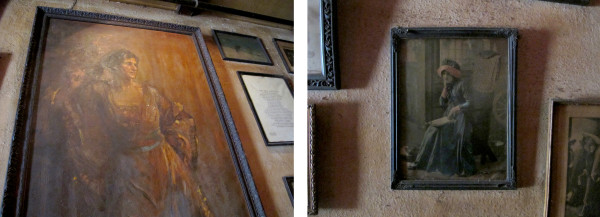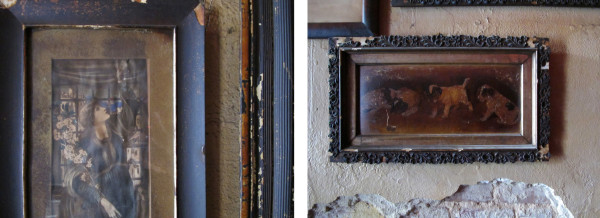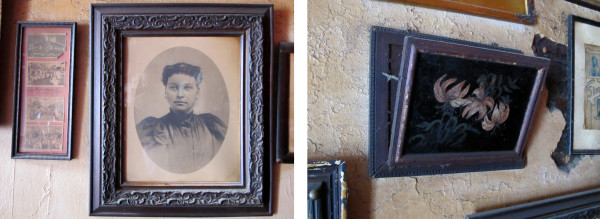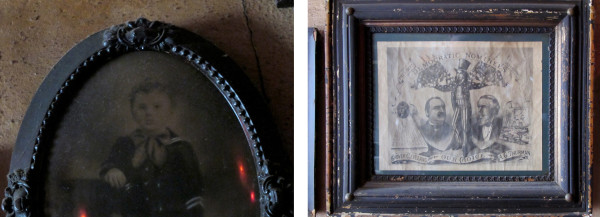This installment of “Sights Unscene” takes a look at one wall of a storied bar in a Houston’s Market Square.
La Carafe–located at 813 Congress–is not the oldest bar in Houston, though the popular misconception is understandable. It is old, and seems even more ancient than is possible. That’s largely because it is housed in the oldest commercial building in the city—a 2-story, brick building erected in the 1840s for John Kennedy’s steam bakery that later served as a trading post, pony express stop, munitions depot, printing shop, and drug store. In the late-1950s, a bar and restaurant was opened in the space, but it wasn’t until William V. Berry took over in 1963 that the funky and romantic meeting place Houstonians know as La Carafe was born. Berry, who passed away this August, bought the building and others in the area, playing a role in the resurgence and vibrant cultural life of Market Square in the 1960s and 70s. He operated La Carafe for 25 years, before passing it to new owners in the late-1980s (who, thankfully, have changed little in their 25 years of operating it.)
 Besides the age and charm of the building, La Carafe’s décor–presumably Mr. Berry’s doing 50 years ago–is another factor in its seeming timeless. The 100-year old, brass cash register–an antique back then–is still in use. There are no TVs or neon signs. It almost seems like you might find Sam Houston’s initials among the hundreds carved into the old wooden bar. (Houston is rumored to have gotten drunk there once, although that was likely nearly a century before the bar opened.) And, of course, its funky selection of old art and artifacts on the walls helps to weave the bar’s story into longer, layered mythology.
Besides the age and charm of the building, La Carafe’s décor–presumably Mr. Berry’s doing 50 years ago–is another factor in its seeming timeless. The 100-year old, brass cash register–an antique back then–is still in use. There are no TVs or neon signs. It almost seems like you might find Sam Houston’s initials among the hundreds carved into the old wooden bar. (Houston is rumored to have gotten drunk there once, although that was likely nearly a century before the bar opened.) And, of course, its funky selection of old art and artifacts on the walls helps to weave the bar’s story into longer, layered mythology.
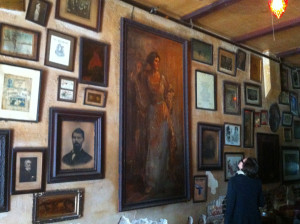 The salon-style constellation of framed antique paintings, photographs, prints, and ephemera lining its main wall–vastly ranging in size, with some pieces touching or overlapping and all of them hanging at least slightly crooked–is an intriguing assemblage of various unknown histories. Largely representations of people, these ghosts have long been gathered here to lurk, some more playfully than others, in conversation with each other, with bar patrons, and with unseen echoes of past saloon circuses. Anchored by one very large painted portrait of a woman, this permanent exhibition (perhaps Houston’s longest running, unaltered art show?) seems more a part of the walls than on them. And, especially in the low light of the bar’s evening ambience, it gives the impression that La Carafe is where all souls—good and bad, gloriously joyful and dreadfully serious—come to raise a glass, get at least slightly crooked, and disappear into time.
The salon-style constellation of framed antique paintings, photographs, prints, and ephemera lining its main wall–vastly ranging in size, with some pieces touching or overlapping and all of them hanging at least slightly crooked–is an intriguing assemblage of various unknown histories. Largely representations of people, these ghosts have long been gathered here to lurk, some more playfully than others, in conversation with each other, with bar patrons, and with unseen echoes of past saloon circuses. Anchored by one very large painted portrait of a woman, this permanent exhibition (perhaps Houston’s longest running, unaltered art show?) seems more a part of the walls than on them. And, especially in the low light of the bar’s evening ambience, it gives the impression that La Carafe is where all souls—good and bad, gloriously joyful and dreadfully serious—come to raise a glass, get at least slightly crooked, and disappear into time.
The dim lighting I’ve mentioned plays as big a role in creating La Carafe’s ambience as the art. Pieces are hung high and are normally only barely illuminated by reddish light fixtures and candles. It’s only in the first hour or two of operation–if it’s sunny outside and the door is wide open–that one can really see what normally acts as ornate, ghostly wallpaper. Now, I don’t normally hit bars so early, but being as dedicated to the enlightenment of Glasstire readers as I am, I recently went to have an early afternoon drink there and photograph some of La Carafe’s main wall. A little sunlight reveals more details–delicate lines, faded colors, frame ornamentation. It also shows the degradation of decades of dust and smoke, but those fades and impressions are part of the experience. Here some photos:


